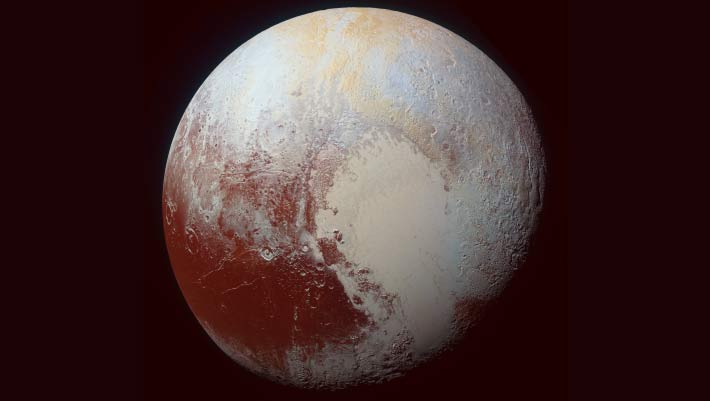Planetary researchers from Washington University in St. Louis and the Lunar and Planetary Institute have used mathematical models and unprecedented high-resolution images from NASA’s New Horizons spacecraft to take a closer look at the subsurface ocean that likely lies beneath Pluto’s thick shell of nitrogen, methane and water ice.
This high-resolution image of Pluto was taken by New Horizons on July 14. Pluto’s surface sports a remarkable range of subtle colors, enhanced in this view to a rainbow of pale blues, yellows, oranges, and deep reds. Many landforms have their own distinct colors, telling a complex geological and climatological story that scientists have only just begun to decode. Image credit: NASA / Johns Hopkins University Applied Physics Laboratory / Southwest Research Institute.
For many decades, planetary scientists assumed that Pluto could not support an ocean.
The surface temperature is about minus 220 degrees Celsius (minus 364 degrees Fahrenheit), a temperature so cold even gases like nitrogen and methane freeze solid. Water shouldn’t have a chance.
“Pluto is a small body,” said Alex Nguyen, a Ph.D. student at Washington University in St. Louis.
“It should have lost almost all of its heat shortly after it was formed, so basic calculations would suggest that it’s frozen solid to its core.”
But in recent years, scientists have gathered evidence suggesting Pluto likely contains an ocean of liquid water beneath the ice.
That inference came from several lines of evidence, including Pluto’s cryovolcanoes that spew ice and water vapor.
“Although there is still some debate, it’s now generally accepted that Pluto has an ocean,” Nguyen said.
The new study probes Pluto’s ocean in greater detail, even if it’s far too deep below the ice for planetary scientists to ever see.
Nguyen and his colleague, Dr. Patrick McGovern of the Lunar and Planetary Institute, created mathematical models to explain the cracks and bulges in the ice covering Pluto’s Sputnik Platina basin, the site of a meteor collision billions of years ago.
Their calculations suggest the ocean in this area exists beneath a shell of water ice 40 to 80 km (25-50 miles) thick, a blanket of protection that likely keeps the inner ocean from freezing solid.
They also calculated the likely density or salinity of the ocean based on the fractures in the ice above.
They estimate Pluto’s ocean is, at most, about 8% denser than seawater on Earth, or roughly the same as Utah’s Great Salt Lake. If you could somehow get to Pluto’s ocean, you could effortlessly float.
“This level of density would explain the abundance of fractures seen on the surface,” Nguyen said.
“If the ocean was significantly less dense, the ice shell would collapse, creating many more fractures than actually observed. If the ocean was much denser, there would be fewer fractures.”
“We estimated a sort of Goldilocks zone where the density and shell thickness is just right.”
Space agencies have no plans to return to Pluto any time soon, so many of its mysteries will remain for future generations of researchers.
“Whether it’s called a planet, a planetoid, or merely one of many objects in the outer reaches of the Solar System, it’s worth studying,” Nguyen said.
“From my perspective, it’s a planet.”
The paper was published in the journal Icarus.
_____
P.J. McGovern & A.L. Nguyen. 2024. The role of Pluto’s ocean’s salinity in supporting nitrogen ice loads within the Sputnik Planitia basin. Icarus 412: 115968; doi: 10.1016/j.icarus.2024.115968




